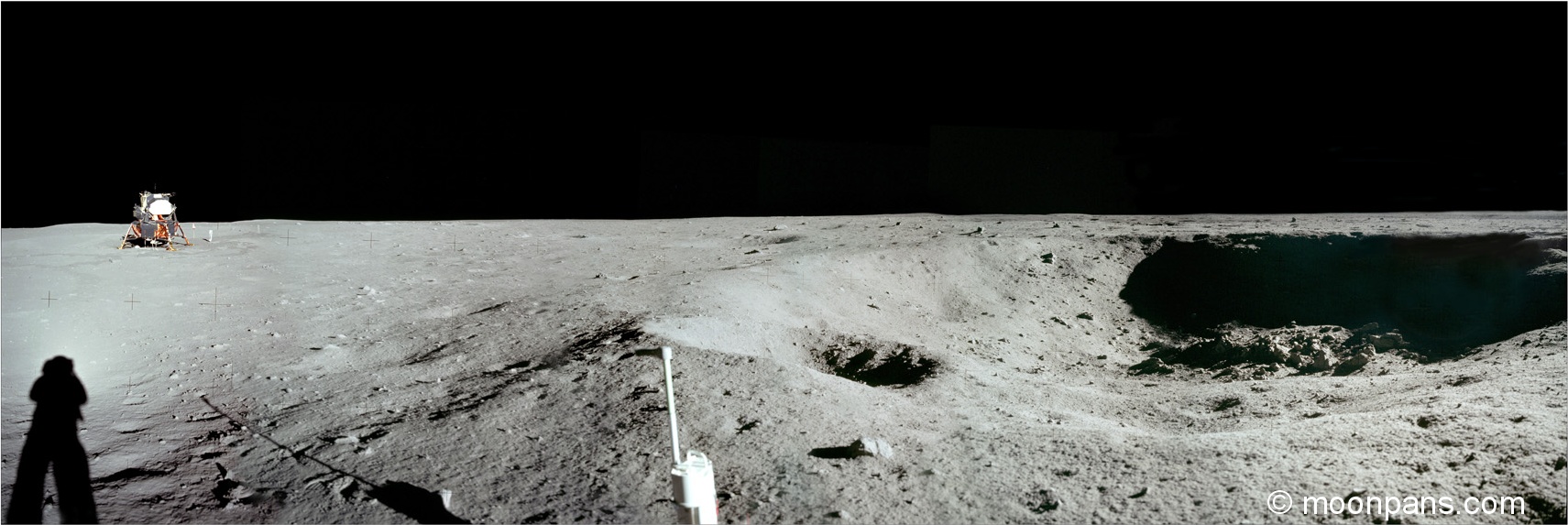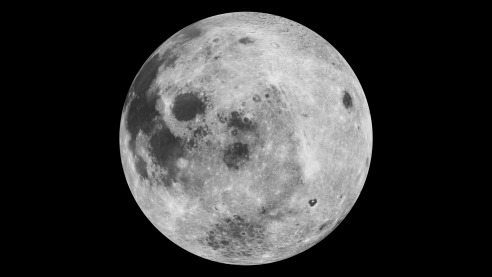 Image 1:Craters and seas on the moon
The lunar surface – a cratered landscape
Image 1:Craters and seas on the moon
The lunar surface – a cratered landscape
20 July 1969 – as the Apollo 11 Lunar Module Eagle approached the surface of the Moon its planned descent path took it towards a large crater surrounded by rocky terrain. With dwindling fuel reserves, pilot Neil Armstrong took manual control, skilfully flying over the boulder-strewn West crater in search of a smooth and safe landing spot.
Anyone who has seen Moon through a small telescope will have been fascinated by the contrast between the smooth, dark surface of the maria and the brighter and heavily cratered lunar highlands. The craters are now known to be impact features, caused by the bombardment of the Moon’s surface by asteroids. In the absence of erosion by wind and water, craters form a permanent record of the history of the surface and can be used to determine the age of different regions of the Moon. Older parts of the lunar surface have relatively large numbers of craters, having been exposed for longer. In contrast, the smoother seas with fewer and smaller craters represent more recent outflows, now solidified, that took place after the end of the main phase of bombardment about 3.8 billion years ago.
 Image 2:Craters Tycho and Clavius
The naming of craters
Image 2:Craters Tycho and Clavius
The naming of craters
In the early part of the 17th century, Galileo Galilei was in possession of one of the first telescopes of sufficient quality for astronomical observations. It was hardly possible to point such an instrument anywhere in the heavens without discovering something amazing. With his telescope, Galileo saw a surface pockmarked with craters and in 1610, he published the Siderius Nuncius – the Starry Messenger, describing his observations of the lunar surface and of the satellites of Jupiter.
The Danish astronomer Tycho Brahe is, of course, is well known as one of the more colourful characters in the history of astronomy and as one of the greatest of the pre-telescopic observers. Tycho’s detailed observations of the position of Mars, meticulously recorded over many years in the latter part of the 16th century, were used by Kepler in developing his laws of planetary motion.
It is completely appropriate that Tycho be honoured with one of the most prominent craters on the Moon. Yet Galileo does not have a major crater to his name – the even larger crater south of Tycho being named Clavius after a relatively little-known 16th-century mathematician and astronomer.
The clue to this mystery lies in the fact that, while he was the first to publish his observations of the lunar surface, it was not Galileo who gave the craters their current names. In 1651, Italian astronomer Giovanni Battista Riccioli (1598 - 1671) published his Almagestun Novum, which contained the first detailed maps of the lunar surface. In the Almagestum, Riccioli established the practice of naming craters after prominent astronomers. Being opposed to the heliocentric system, Riccioli reserved the largest craters for those who supported the idea of the Earth as the centre of the Solar System – these included Ptolemy and Tycho (who espoused a hybrid model). Riccioli named the most spectacular crater of all after his predecessor, the German astronomer and mathematician Christoph Klau Clavius (1538 - 1612). At over 230 km in diameter Clavius with its curving chain of secondary craters is one of the most distinctive and imposing features on the Moon’s surface and a popular target for observers, a host of detail is visible in even small telescopes.
Galileo himself was given only a very insignificant memorial – the small 16 km crater Galilei in the western Oceanus Procellarum.
 Image 3: Lunar Reconnaissance orbiter image_migrate
Apollo 11 astronauts get their own craters
Image 3: Lunar Reconnaissance orbiter image_migrate
Apollo 11 astronauts get their own craters
In this 50th anniversary year, it is fitting that the crew of Apollo 11 have their own craters. After a nerve-racking few minutes and with approximately 30 seconds of fuel left, the Lunar Module Eagle, crewed by Neil Armstrong and Buzz Aldrin, landed safely in the Sea of Tranquility. The third crew member, Michael Collins, remained in orbit in the Command Module. Although it had been a hazard to navigation during the descent, West crater eventually proved a valuable source of selenological samples, as many of the moon rocks returned to Earth by Apollo 11 were ejecta from the crater.
To honour their achievement three small craters just to the north of the Apollo 11 landing site were named Armstrong, Aldrin and Collins. With the supply of large craters having long since been used up these craters are no more than 5 km across. Nevertheless on a clear and still night they can be seen using a small telescope, forming a line to the east of the two larger craters Ritter and Sabine – a lasting reminder of the first humans to step on another world.
IMAGE 3: Lunar Reconnaissance Orbiter image of Crater Armstrong, Aldrin, Collins in the Sea of Tranquility. The landing site is marked with a red ‘X’. A close up of the landing site and the Eagle lunar module can be seen at this website.
 Panorama of tranquillity base, showing little West crater. Image Credit: NASA, moonpans.com
Panorama of tranquillity base, showing little West crater. Image Credit: NASA, moonpans.com
With thanks to Isaac Asimov, whose story “The Key”, published in Asimov’s Mysteries (Asimov, 1969), inspired part of this article.




Rate and Review
Rate this article
Review this article
Log into OpenLearn to leave reviews and join in the conversation.
Article reviews